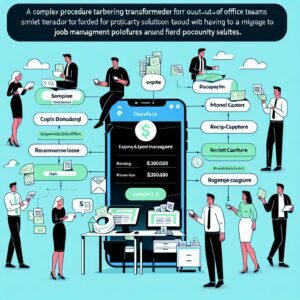Starting a journey for a corporate excursion can be a whirlpool of commotion, but the genuine expedition frequently commences upon arrival, when confronted with a heap of receipts and the intimidating mission of maneuvering through your organization’s protocol for its travel reimbursement policy. This guide acts as your essential resource for understanding and mastering the intricacies of these policies, ensuring that you receive reimbursement for every eligible penny spent.
Understanding the Basics: What is a Travel Reimbursement Policy?
At its core, a travel reimbursement policy is a set of rules that governs how employees can claim expenses incurred on business trips. These guidelines are tailored to each company, detailing eligible expenses and the process for submitting claims. They’re the blueprint for fair compensation, covering transportation, lodging, meals, and other incidental costs.
Expense Categories
- Transportation: Flights, trains, taxis, and more.
- Accommodation: Hotels and rentals.
- Meals and Entertainment: Daily allowances based on location.
- Incidentals: Parking fees, internet charges, etc.
Spend Limits
These policies often set spending limits to prevent excessive claims, such as daily meal caps or maximum hotel rates.
Required Documentation
Receipts, invoices, and boarding passes are the keystones of a solid claim, providing the evidence needed to back up your expenses.
Approval Process
Understanding the chain of command for approvals is crucial to a smooth reimbursement experience.



Eligible Expenses: What Can You Claim?
Knowing what you can claim is half the battle. From efficient expense management solutions to transportation costs, here’s a breakdown of typical reimbursable expenses:
Transportation Costs
- Airfare, train tickets, rental cars, and taxi fares.
- Keep all travel documents as proof.
Accommodation Expenses
- Hotel stays and rentals are reimbursable.
- Save hotel bills or rental agreements.
Meals and Entertainment Allowances
- Companies usually provide a daily meal allowance.
- Document your meal expenses within the set limits.
Incidental Expenses
- Claim parking fees, internet charges, and tips.



Appropriate Documentation: How to Keep Track of Your Expenses
Organization is key when it comes to reimbursement. Here’s how to keep your expenses in check:
Save All Receipts
Collect and save every receipt related to your business expenses. Consider using a receipt management app for digital storage and easy access.
Record Details
For each expense, jot down the date, location, and purpose. This will streamline your claim process.
Use Digital Tools
Embrace digital tools and apps for expense tracking. They can automate the process, making it less of a chore.
Submission Procedures: Navigating the Reimbursement Process
With your documentation in order, it’s time to submit your claim. Here’s a step-by-step guide:
Create an Expense Report
Compile a detailed report of your expenses, complete with all supporting documents.
Submit Your Expense Report
Follow your company’s procedures, whether it’s through an online portal or via email, to submit your report.
Reimbursement Timelines: When Can You Expect to Get Paid?
Timelines for reimbursement vary, but most companies have set periods for processing claims. Stay informed about these timelines and follow up if necessary.
Tips and Strategies for Maximizing Your Reimbursement
Maximizing your reimbursement is an art. Here’s how to master it:
Plan Ahead
Review your company’s policy before your trip to understand the coverage and limits.
Keep Track of Expenses in Real-Time
Document expenses as they occur to ensure accuracy and ease the reimbursement process.
Submit Claims Promptly
Don’t delay in submitting your expense report. The quicker you submit, the faster you’ll be reimbursed.
Common Pitfalls to Avoid: Mistakes that Could Delay or Deny Your Reimbursement
Even with the best intentions, mistakes can happen. Here’s what to avoid:
Inadequate Documentation
Lack of proper receipts and invoices is a common reason for reimbursement hiccups.
Non-Compliance with Policy Guidelines
Stick to the rules set out in your company’s policy to avoid any reimbursement roadblocks.
Travel Reimbursement Policy Best Practices: Recommendations for Employers
For employers, crafting a clear and concise policy is paramount. Here are some best practices:
Clear Communication
Ensure all employees are well-versed in the policy’s details, from eligible expenses to submission guidelines.
Simplify Procedures
Streamline the process to avoid confusion and make it easier for employees to submit their claims. As we navigate the complexities of travel reimbursement, it’s clear that a solution like Clyr can transform this often cumbersome process into a seamless experience. With Clyr’s ability to integrate with major management platforms and provide real-time expense notifications, the days of manual tracking and lengthy reimbursement cycles can be a thing of the past.



Crafting a Travel Reimbursement Policy That Works for Everyone Leveraging Technology for Efficient Reimbursement
In the age of digital transformation, leveraging technology is not just a convenience—it’s a necessity for efficient expense management solutions. With the right tools, the reimbursement process can be significantly streamlined, reducing the time from submission to payment. Here’s how technology can make a difference:
- Automated Financial Reporting for Out-of-Office Teams: For teams that are constantly on the move, automated financial reporting can be a game-changer. It ensures that expenses are logged and categorized accurately, which is essential for timely reimbursement.
- Integration-Friendly Financial Tools for Property Management: Property management teams often juggle multiple tasks and expenses. Integration-friendly financial tools can synchronize financial data across platforms, making it easier to track and manage expenses.
- Real-Time Expense Tracking Software: Real-time tracking allows for immediate recording of expenses, which can prevent the loss of receipts and ensure that no expense goes unclaimed.
By adopting top financial reporting software for field teams, companies can benefit from a more cohesive and transparent expense management process. Clyr, for instance, offers seamless financial data synchronization for field services, ensuring that every dollar spent is accounted for and reimbursed accordingly.
The Role of Mobile Apps in Expense Management
Mobile apps have revolutionized the way we manage our expenses on the go. They offer the convenience of capturing receipts and tracking expenses in real-time, which is particularly beneficial for employees who are often out of the office. Here are some advantages of using mobile apps for expense management:
1. Instant Receipt Capture: Snap a photo of your receipt, and it’s securely stored and ready for your expense report.
2. On-the-Spot Expense Entry: Enter expenses as they happen, reducing the risk of forgetting or losing track of them.
3. Accessibility: Access your expense records anywhere, anytime, right from your smartphone.
For example, a receipt management app can simplify the process of collecting and organizing receipts, making it easier for employees to submit accurate expense reports. This not only saves time but also reduces the likelihood of errors that could delay reimbursement.
How to Handle International Travel Expenses
International travel adds another layer of complexity to expense management. Currency conversions, varying tax laws, and additional documentation requirements can complicate the reimbursement process. Here are some tips for handling international travel expenses:
- Understand Currency Exchange Rates: Keep track of the exchange rates at the time of each transaction to ensure accurate reimbursement.
- Know the Tax Implications: Different countries have different tax laws. Be aware of what can and cannot be claimed as a business expense.
- Use Efficient Expense Management Solutions: Choose a platform that can handle multiple currencies and automate the conversion process.
For businesses with international operations, it’s crucial to have efficient expense management solutions that can adapt to the complexities of global travel. This not only simplifies the reimbursement process but also ensures compliance with international financial regulations.



Addressing Common Questions About Travel Reimbursement
Travel reimbursement policies can be complex, and employees often have questions about what they can claim and how to go about it. Here are some common questions and their answers:
- What if I lose a receipt?- Check if your company accepts credit card statements or if they have a specific policy for lost receipts. Some companies may allow a signed statement explaining the expense.
- Can I claim expenses for leisure activities during a business trip? – Typically, only business-related expenses are reimbursable. However, some companies may allow for a reasonable amount of leisure expenses if they do not add additional cost to the trip.
- How do I claim mileage if I use my personal car?- Companies usually reimburse mileage at a standard rate. Keep a log of your business travel mileage to submit with your expense report.
- How can I address a delay in my reimbursement? – Take the initiative to follow up with your finance department. While delays can happen, it is crucial to verify that your claim is being processed.
By addressing these questions proactively, companies can alleviate concerns and make the reimbursement process smoother for everyone.
The Future of Travel Reimbursement: Trends and Predictions
The landscape of travel reimbursement is evolving with technology and changing work patterns. Here are some trends and predictions for the future:
- Increased Automation: With platforms like Clyr, we can expect more expense management automation, reducing manual entry and speeding up the reimbursement cycle.
- Mobile-First Solutions: As remote work becomes more common, mobile apps will play a larger role in expense management.
- Personalized Expense Policies: Companies may start to offer more personalized policies that cater to individual needs and work habits.
- Integration with Travel Booking: Seamless integration with travel booking systems will allow for pre-approval of expenses and automatic tracking.
These advancements will not only make the process more efficient but also more employee-friendly, leading to higher satisfaction and compliance.
Case Studies: Successful Reimbursement Stories
Let’s explore a few case studies where companies have successfully implemented efficient expense management solutions:
- A Tech Startup: By using expense report automation, a growing tech company reduced its reimbursement cycle from weeks to just a few days, improving employee satisfaction.
- A Consulting Firm: With the adoption of real-time expense tracking software, consultants could submit expenses on the go, leading to real-time budget updates and better financial planning.
- A Nonprofit Organization: By simplifying job costing with financial software, a nonprofit was able to allocate funds more accurately and report to donors more transparently.
These stories highlight the positive impact of adopting modern expense management practices.
Expert Insights: Interviews with Finance Professionals
In conversations with finance professionals, several key points are consistently highlighted:
- The Importance of Policy Clarity: Clear policies prevent confusion and ensure that employees know what’s expected of them.
- The Role of Technology: There’s a consensus that technology, especially expense reporting in QuickBooks and similar integrations, is crucial for efficiency.
- Employee Training: Educating employees on the use of expense management tools is essential for maximizing their benefits. These insights from experts underscore the need for companies to invest in both technology and employee training.
The Intersection of Travel Policies and Employee Satisfaction
Employee satisfaction is closely tied to how travel policies are structured and implemented. A fair and transparent policy can lead to:
- Boosted Morale: The sense of being valued among employees is heightened when they are assured that their expenses will be reimbursed effortlessly.
- Better Compliance: Clear guidelines and easy-to-use tools encourage employees to comply with the policy.
- Attracting Talent: Competitive reimbursement policies can be a factor in attracting and retaining top talent.
By considering employee satisfaction, companies can create policies that are beneficial for both the staff and the organization.
Crafting a Travel Reimbursement Policy That Works for Everyone
Creating a travel reimbursement policy that meets the needs of both the company and its employees involves several key steps:
- Gather Input: Include feedback from employees who travel frequently to understand their needs and challenges.
- Define Clear Guidelines: Establish what is and isn’t reimbursable, and under what circumstances.
- Leverage Technology: Implement tools like Clyr to streamline the process and reduce administrative burdens.
- Regularly Review and Update: As business needs and travel norms evolve, so should your policy.
By crafting a well-thought-out policy, companies can ensure a smooth reimbursement process that supports their financial goals and keeps employees content.